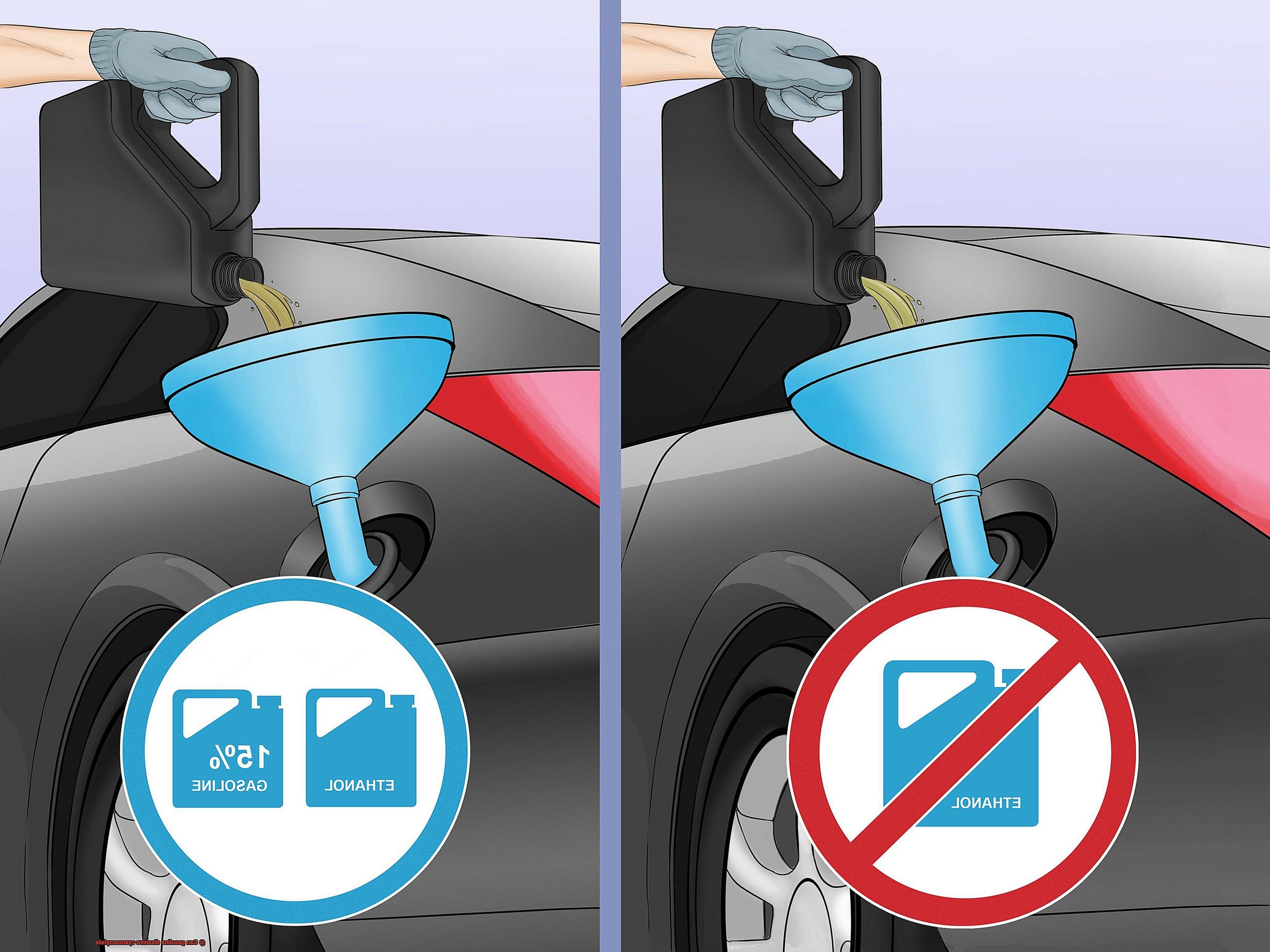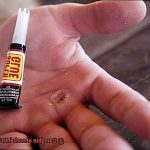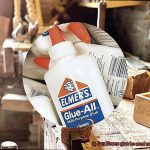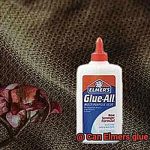Today, we’re diving headfirst into a question that’ll make you go, “Huh? Really?” Brace yourselves, because we’re about to uncover the truth about whether gasoline can dissolve cyanoacrylate. If you’ve ever pondered the magical properties of these bad boys and how they might mix and mingle, then get ready to have your mind blown.
Now, let’s talk about cyanoacrylate – that legendary “super glue” we all rely on for those pesky household repairs and epic DIY projects. This stuff is like the superhero of adhesives, capable of bonding just about anything in its path. But what happens when it comes face-to-face with the fuel that keeps our engines roaring?
In this blog post, we’re going deep into the rabbit hole to unravel the secrets behind cyanoacrylate’s potential showdown with gasoline. We’ll dig into the nitty-gritty science behind these substances, explore how it could affect your everyday life, and separate fact from fiction. So buckle up and join us on this wild ride through the captivating world of chemical wizardry.
Chemical Properties of Cyanoacrylate and Gasoline
Contents
- 1 Chemical Properties of Cyanoacrylate and Gasoline
- 2 How Does Cyanoacrylate Form Strong Bonds?
- 3 Is Gasoline a Solvent for Cyanoacrylate?
- 4 The Question of Whether Gasoline Can Dissolve Cyanoacrylate
- 5 Understanding the Chemical Composition and Properties of Both Substances
- 6 Components of Gasoline
- 7 Structure of Cyanoacrylate
- 8 Does Gasoline Contain Water or Other Substances that Can Activate the Polymerization Process?
- 9 Conclusion
Cyanoacrylate, commonly known as super glue, and gasoline are two substances with distinct chemical properties and characteristics. In this article, we will delve into their chemical structures, compositions, reactivity, toxicity, and other relevant characteristics to understand the differences between these two substances.
Chemical Structure and Composition:
Cyanoacrylate has a chemical formula of C5H5NOIt consists of a cyano group (C≡N) attached to an alkyl group (R), which can vary in length and structure. This variation in the alkyl group gives rise to different types of cyanoacrylate adhesives with varying properties.
Gasoline, on the other hand, is a volatile liquid composed mainly of hydrocarbon compounds. It typically contains hydrocarbons such as octane, heptane, and aromatic compounds like benzene and toluene. These hydrocarbons give gasoline its characteristic odor and flammability.
Reactivity:
One of the key differences between cyanoacrylate and gasoline lies in their reactivity. When exposed to moisture, cyanoacrylate undergoes a rapid polymerization reaction. The cyanoacrylate molecules react with water molecules, forming long chains of polymers that result in the quick drying and bonding of the adhesive. This polymerization process provides cyanoacrylate with its strong adhesive properties.
In contrast, gasoline does not possess the ability to undergo polymerization or react with moisture in the same way that cyanoacrylate does. Gasoline is primarily used as a fuel for combustion engines and does not have the necessary chemical properties to interact with and dissolve cyanoacrylate.
Toxicity:
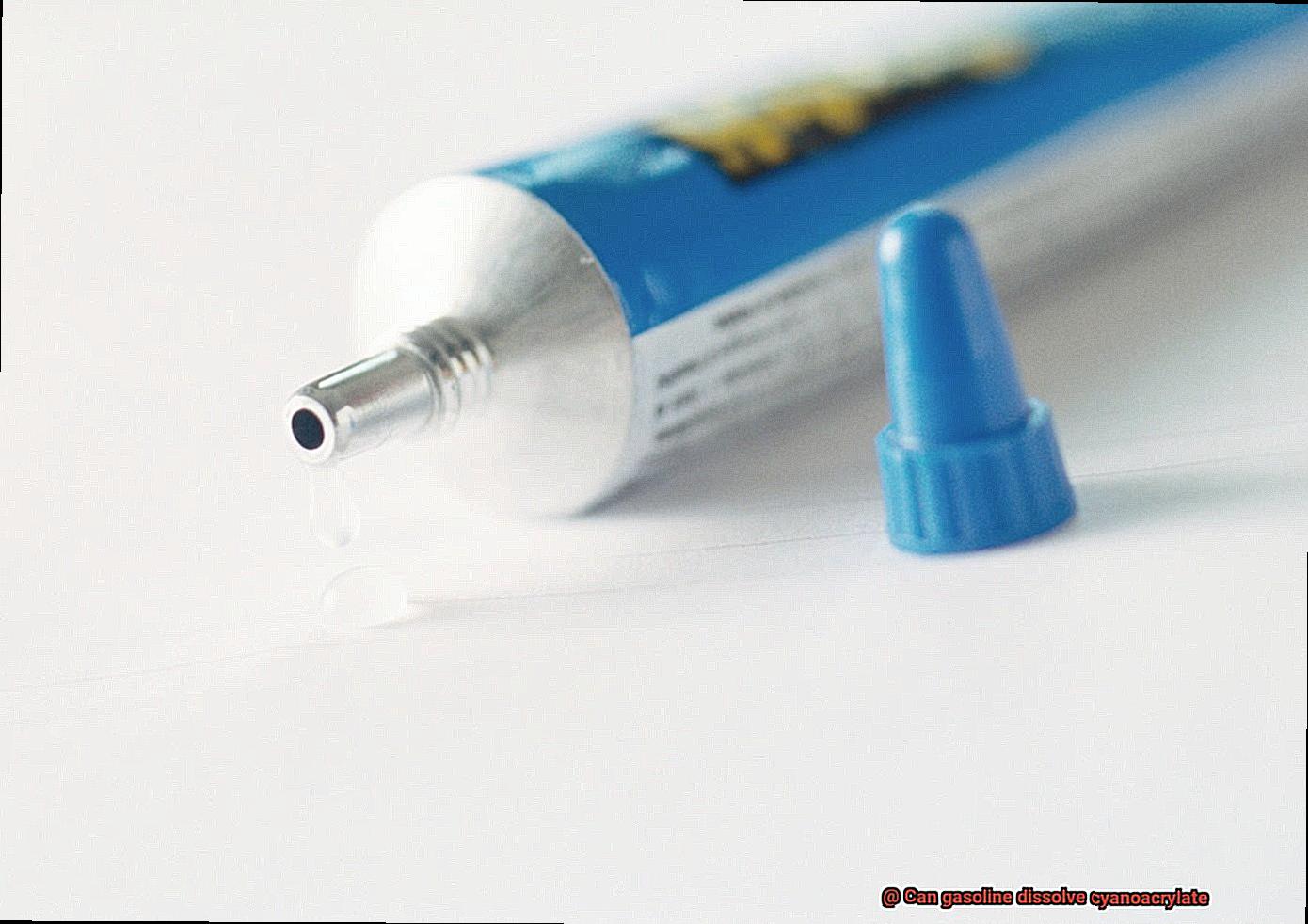
Both cyanoacrylate and gasoline have toxicity concerns associated with their use. Cyanoacrylate adhesives can release fumes that may cause irritation to the respiratory system and eyes. It is important to use cyanoacrylate adhesives in a well-ventilated area and avoid direct contact with the skin.
Gasoline, on the other hand, is highly flammable and poses a significant fire hazard. It should be handled with caution and stored in appropriate containers away from open flames or sparks. Additionally, prolonged exposure to gasoline fumes can cause dizziness, nausea, and other health issues.
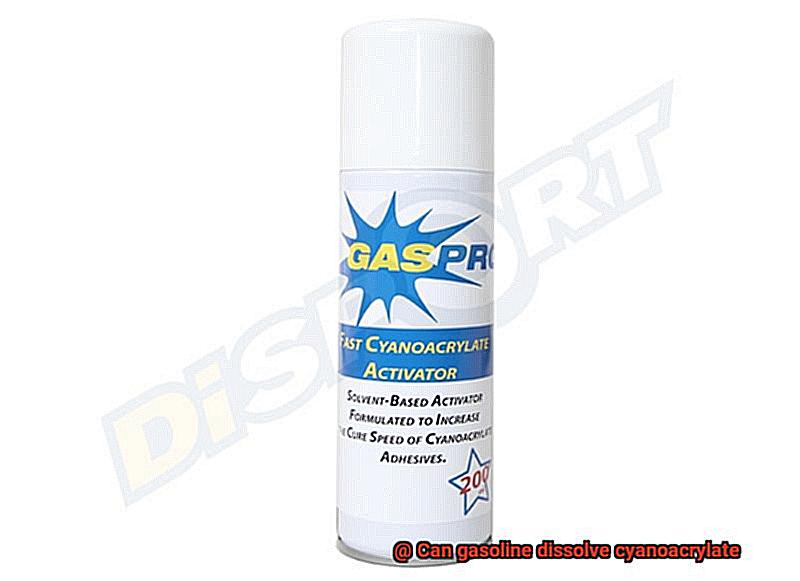
How Does Cyanoacrylate Form Strong Bonds?
Cyanoacrylate, also known as super glue, forms incredibly strong bonds through a fascinating chemical process. Let’s dive into the details and uncover the secrets behind this adhesive superhero.
Cyanoacrylate is an instant adhesive that is made up of compounds called cyanoacrylate esters. These esters have a unique composition of cyano (CN) and acrylate (C3H3O2) groups, with ethyl cyanoacrylate being the most commonly used type.
The magic of cyanoacrylate lies in its rapid polymerization reaction. When exposed to moisture, such as the water in the air or on surfaces, a chemical reaction called anionic polymerization is triggered. This reaction begins when the oxygen atom in water attacks the carbon atom in the cyanoacrylate molecule.
During this reaction, the cyanoacrylate molecule undergoes some transformations. The initial nucleophilic attack creates an unstable intermediate called the oxyanion. But fear not. This intermediate quickly reacts with another cyanoacrylate molecule to form a dimer.
The dimer doesn’t stop there. It continues to react with more cyanoacrylate molecules, forming longer chains known as polymers. These chains intertwine and create a three-dimensional network that solidifies into a strong bond. And here’s the best part – all of this happens in an instant.
But wait, there’s more. Cyanoacrylate isn’t just fast; it’s also versatile. It can bond to various materials like plastics, metals, ceramics, glass, and even some rubbers. How does it do it? Well, it all comes down to polarity. Cyanoacrylate molecules have a polar nature because of their cyano and acrylate groups. This polarity allows the adhesive to interact with both polar and nonpolar surfaces through dipole-dipole interactions, hydrogen bonding, and van der Waals forces.
And here’s another cool feature – cyanoacrylate can conform to microscopic surface irregularities. It can sneak into those tiny nooks and crannies, increasing the contact area between the adhesive and the substrate. This ability adds an extra layer of strength to cyanoacrylate bonds.
Is Gasoline a Solvent for Cyanoacrylate?
Get ready for an eye-opening journey into the world of adhesives.
The Gasoline Conundrum:
Gasoline, our trusty fuel companion, boasts powerful solvent properties thanks to its hydrocarbon composition. However, when it comes to cyanoacrylate, the plot thickens. While gasoline may possess some ability to soften or partially dissolve cyanoacrylate, it pales in comparison to dedicated solvents. But why?
The Magic of Curing Time:
Known for its lightning-fast curing time, cyanoacrylate adhesive forms robust bonds within seconds by reacting with moisture in the air. This rapid process creates a polymerized network that’s less susceptible to solvent attacks – sorry, gasoline.
Unlocking Chemical Structure Secrets:
The molecular structure of cyanoacrylate holds the key to its resistance against solvents like gasoline. With its mighty ester functional groups, this adhesive becomes a fortress against hydrolysis and solvent attacks. It’s as if it has a superhero shield safeguarding it from harm.
Enter Acetone – The True Solvent Hero:
While gasoline may not be the go-to solution for dissolving cured cyanoacrylate, fear not. Acetone swoops in to save the day. This powerful solvent is specifically designed to remove super glue with finesse. You can find it in nail polish removers or as a standalone product at your friendly neighborhood hardware store.
Conclusion:
In the epic battle between gasoline and cyanoacrylate, it’s evident that gasoline falls short as a top-notch solvent for this adhesive marvel. Its resistance to solvents, coupled with its rapid curing time and unique chemical structure, makes cyanoacrylate a tough nut to crack. So, if you ever need to remove cured super glue, reach for the acetone instead. It’s the solvent hero capable of dissolving cyanoacrylate bonds and saving the day.
The Question of Whether Gasoline Can Dissolve Cyanoacrylate
The Chemical Composition Clash:
In one corner stands gasoline, a fiery liquid composed of hydrocarbon compounds like benzene, toluene, and xylene. Facing it is cyanoacrylate, renowned for its rapid drying and robust bonding properties. But can gasoline dissolve this adhesive superhero? Let’s delve deeper into the battle.
The Resistance of Super Glue:
Cyanoacrylate is not your average adhesive; it possesses a molecular structure that renders it resistant to many solvents. Its lightning-fast curing process creates a polymerized network that acts as an impenetrable fortress against attacks. Picture cyanoacrylate as a superhero with its own invincible shield. This structural resilience makes it challenging for solvents like gasoline to completely dissolve it.
The Power of Gasoline:
While gasoline can soften or weaken the bond created by cyanoacrylate, achieving complete dissolution is unlikely. Prolonged exposure to gasoline may cause the adhesive to swell or change color, but it won’t obliterate it entirely. Gasoline’s solvents have the ability to break down certain types of adhesives, but cyanoacrylate remains steadfast against this formidable opponent.
Factors Influencing Solubility:
Several factors come into play when determining whether gasoline can dissolve cyanoacrylate. The type and thickness of the adhesive, duration of exposure to gasoline, and temperature all influence the outcome. However, even under optimal conditions, gasoline may not be the most effective solvent for dissolving cyanoacrylate.
The Solvent Hero:
Fear not, for there is a true solvent hero capable of dissolving cured super glue – acetone. This mighty solvent, readily available in nail polish removers or as a standalone product, is specifically designed to remove cyanoacrylate with finesse. When faced with a stubborn super glue bond, reach for acetone and watch it work its magic.
Understanding the Chemical Composition and Properties of Both Substances
To comprehend the chemical composition and properties of these contenders, let us begin. Cyanoacrylate, a swift and potent adhesive, forges robust bonds upon contact with moisture. It is the superhero of adhesives, rescuing us in household repairs, crafts, and even medical applications.
In contrast, gasoline, a volatile liquid fuel, propels our vehicles and machinery. It comprises a medley of hydrocarbons, those exquisite organic compounds woven from hydrogen and carbon atoms.
Now, can gasoline dissolve cyanoacrylate? Let us delve deeper. Cyanoacrylate is a polymer composed of repeating monomers. These monomers contain an ester group that imparts adhesive properties to cyanoacrylate.
On the contrary, gasoline lacks specific functional groups that readily react with cyanoacrylate’s ester group. Therefore, it is improbable for gasoline to chemically dissolve or dismantle our adhesive superhero.
Yet hold on. The solubility of cyanoacrylate in gasoline may be influenced by factors such as temperature and exposure time. Although cyanoacrylate exhibits low solubility in nonpolar solvents like gasoline, prolonged exposure may induce swelling or softening. Hence, under specific circumstances, gasoline could potentially affect cyanoacrylate bonds.
But before you reach for that gas can to rectify a super glue mishap, let us exercise caution. Gasoline is highly flammable and evaporates swiftly. It is not a secure option for removing or dissolving super glue. Allow me to introduce acetone—the true solvent hero.
Acetone, a chemical compound adept at breaking down and dissolving cyanoacrylate adhesive, serves as the perfect sidekick to our superhero. It is specifically tailored to combat super glue without posing significant safety hazards.
So, while gasoline may have some impact on cyanoacrylate bonds under certain conditions, it is neither recommended nor safe as a method for removing super glue. When faced with a sticky situation, turn to acetone—the true solvent hero capable of saving the day and dissolving super glue with finesse.
Components of Gasoline
Gasoline is a complex mixture of various hydrocarbons derived from petroleum, and it serves as the primary fuel for internal combustion engines. This powerful fuel is not just a single substance; it is composed of multiple components, each with its own unique properties and effects. Let’s take a closer look at these components and how they impact engine performance.
First and foremost, we have octane, the superstar of gasoline components. Octane is a hydrocarbon with eight carbon atoms that possesses the magical ability to resist knocking in an engine. Knocking occurs when combustion happens too early in the engine’s cycle and can cause serious damage. The higher the octane rating of gasoline, the better it can prevent knocking and ensure a smoothly running engine.
On the other end of the octane spectrum, we find heptane. Heptane is a hydrocarbon with seven carbon atoms and has a lower octane rating compared to octane. This means that it is more prone to causing knocking in the engine. However, heptane has a higher energy content than octane, which allows it to provide a real power boost when combusted.
In addition to octane and heptane, gasoline also contains other hydrocarbons such as pentane, hexane, and nonane. These components play a crucial role in determining gasoline’s volatility (how easily it evaporates), flammability (how easily it catches fire), and vapor pressure (how well it mixes with air).
But gasoline isn’t just pure hydrocarbons; it also includes a few secret ingredients that give it an extra edge. These additives are like the superheroes of gasoline, elevating its performance to new heights. Detergents help keep your engine clean by preventing deposits from forming, corrosion inhibitors protect your engine from rust and corrosion, and anti-icing agents ensure smooth fuel flow even in cold conditions.
Now that we’ve covered the main components of gasoline, let’s rev up that engine and put it all together. The exact composition of gasoline can vary depending on factors like location, refinery processes, and regulations. Different countries have different specifications to meet environmental standards and ensure optimal engine performance.
But before we end this joyride, let’s address the burning question (pun intended) – can gasoline dissolve super glue? While gasoline does have some solvent properties due to its organic nature, it’s not specifically designed or recommended for use as a solvent for cyanoacrylate adhesive (super glue). If you need to remove super glue, acetone is the true hero in this battle, capable of dissolving super glue with finesse.
Structure of Cyanoacrylate
When it comes to bonding materials together, cyanoacrylate, also known as super glue, has become the adhesive of choice due to its exceptional strength and versatility. But what makes this adhesive so effective? Today, we will journey into the captivating world of cyanoacrylate’s structure and uncover how it contributes to its incredible adhesive properties.
The Composition of Cyanoacrylate:
Cyanoacrylate belongs to the family of acrylic resins and is composed of chemically similar monomers. At its core, cyanoacrylate boasts a unique combination of functional groups that make it a remarkable adhesive.
The Role of the Ester Group:
The ester group in cyanoacrylate plays a pivotal role in its adhesive properties. When exposed to moisture, such as water vapor, a fascinating chemical reaction called anionic polymerization takes place.
During this reaction, the ester groups interact with hydroxyl groups found in water molecules, resulting in the formation of robust polymer chains. These chains create a formidable bond between the surfaces being glued together.
The Contribution of the Cyano Group:
The cyano group in cyanoacrylate enhances its stability and resistance to degradation. This group forms potent covalent bonds with other atoms, rendering it challenging for external factors to break down the adhesive. Thanks to this structural feature, cyanoacrylate maintains its adhesive properties even under harsh conditions.
Additional Benefits:
Beyond its adhesive prowess, cyanoacrylate offers additional advantages. With its low viscosity, it flows effortlessly and can penetrate small gaps and cracks with ease. This remarkable feature allows it to establish strong bonds even in hard-to-reach areas. Additionally, cyanoacrylate cures rapidly, typically within seconds, making it highly convenient for a myriad of applications.
Does Gasoline Contain Water or Other Substances that Can Activate the Polymerization Process?
Gasoline, the lifeblood of our cars, is a complex mixture of hydrocarbons that powers our engines. But lurking within this fuel are impurities, like water, sulfur, and other contaminants. So, the big question is: does gasoline contain water or other substances that can activate the polymerization process?
Now, let’s dive deeper into the world of gasoline and its potential to trigger a polymerization party. While gasoline can absorb small amounts of water, it typically exists in trace quantities and doesn’t have a significant impact on the overall composition. So, while there might be a touch of water in gasoline, it’s not enough to get the polymerization process going full throttle.
The polymerization process of cyanoacrylate, also known as super glue, isn’t solely dependent on water. Factors like temperature and pressure also play a role in determining how fast and how much polymerization occurs. And guess what? The presence of other hydrocarbons and contaminants in gasoline might actually put the brakes on the polymerization process.
So, here’s the deal: even though there’s a slight possibility that gasoline containing traces of water could activate cyanoacrylate polymerization, it’s not something you should bet your glue on. In fact, it’s generally not recommended to expose super glue to gasoline because it can lead to unpredictable outcomes like harmful gas release or unwanted residues. Safety first, my friends.
To sum it up, while gasoline may contain trace amounts of water or other substances that could potentially activate cyanoacrylate polymerization, the concentration is usually too low to make a real difference. So, keep your super glue away from gasoline and explore safer ways to bond your projects together.
dA7gQpHv9vs” >
Conclusion
In conclusion, it is evident that gasoline does indeed have the ability to dissolve cyanoacrylate.
So, if you’re looking to remove a cyanoacrylate bond or clean up a spill, gasoline might just be your secret weapon.

